Genetic identity of thermosensory relay neurons in the lateral parabrachial nucleus
- PMID: 26491097
- PMCID: PMC4747895
- DOI: 10.1152/ajpregu.00094.2015
Genetic identity of thermosensory relay neurons in the lateral parabrachial nucleus
Abstract
The parabrachial nucleus is important for thermoregulation because it relays skin temperature information from the spinal cord to the hypothalamus. Prior work in rats localized thermosensory relay neurons to its lateral subdivision (LPB), but the genetic and neurochemical identity of these neurons remains unknown. To determine the identity of LPB thermosensory neurons, we exposed mice to a warm (36°C) or cool (4°C) ambient temperature. Each condition activated neurons in distinct LPB subregions that receive input from the spinal cord. Most c-Fos+ neurons in these LPB subregions expressed the transcription factor marker FoxP2. Consistent with prior evidence that LPB thermosensory relay neurons are glutamatergic, all FoxP2+ neurons in these subregions colocalized with green fluorescent protein (GFP) in reporter mice for Vglut2, but not for Vgat. Prodynorphin (Pdyn)-expressing neurons were identified using a GFP reporter mouse and formed a caudal subset of LPB FoxP2+ neurons, primarily in the dorsal lateral subnucleus (PBdL). Warm exposure activated many FoxP2+ neurons within PBdL. Half of the c-Fos+ neurons in PBdL were Pdyn+, and most of these project into the preoptic area. Cool exposure activated a separate FoxP2+ cluster of neurons in the far-rostral LPB, which we named the rostral-to-external lateral subnucleus (PBreL). These findings improve our understanding of LPB organization and reveal that Pdyn-IRES-Cre mice provide genetic access to warm-activated, FoxP2+ glutamatergic neurons in PBdL, many of which project to the hypothalamus.
Figures
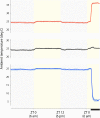
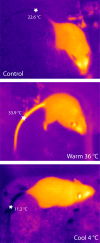
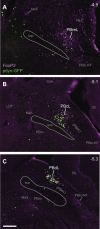
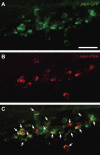
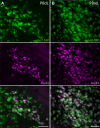
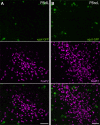

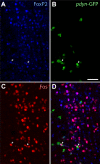

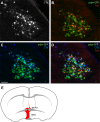

Similar articles
-
Efferent projections of Vglut2, Foxp2, and Pdyn parabrachial neurons in mice.J Comp Neurol. 2021 Mar;529(4):657-693. doi: 10.1002/cne.24975. Epub 2020 Sep 21. J Comp Neurol. 2021. PMID: 32621762 Free PMC article.
-
Two Ascending Thermosensory Pathways from the Lateral Parabrachial Nucleus That Mediate Behavioral and Autonomous Thermoregulation.J Neurosci. 2023 Jul 12;43(28):5221-5240. doi: 10.1523/JNEUROSCI.0643-23.2023. Epub 2023 Jun 20. J Neurosci. 2023. PMID: 37339876 Free PMC article.
-
Parabrachial opioidergic projections to preoptic hypothalamus mediate behavioral and physiological thermal defenses.Elife. 2021 Mar 5;10:e60779. doi: 10.7554/eLife.60779. Elife. 2021. PMID: 33667158 Free PMC article.
-
Central circuitries for body temperature regulation and fever.Am J Physiol Regul Integr Comp Physiol. 2011 Nov;301(5):R1207-28. doi: 10.1152/ajpregu.00109.2011. Epub 2011 Sep 7. Am J Physiol Regul Integr Comp Physiol. 2011. PMID: 21900642 Review.
-
Prostaglandin E2 production in the brainstem parabrachial nucleus facilitates the febrile response.Temperature (Austin). 2024 Sep 24;11(4):309-317. doi: 10.1080/23328940.2024.2401674. eCollection 2024. Temperature (Austin). 2024. PMID: 39583895 Free PMC article. Review.
Cited by
-
Extended amygdala-parabrachial circuits alter threat assessment and regulate feeding.Sci Adv. 2021 Feb 26;7(9):eabd3666. doi: 10.1126/sciadv.abd3666. Print 2021 Feb. Sci Adv. 2021. PMID: 33637526 Free PMC article.
-
Activation of Transient Receptor Potential Vanilloid 1 Channels in the Nucleus of the Solitary Tract and Activation of Dynorphin Input to the Median Preoptic Nucleus Contribute to Impaired BAT Thermogenesis in Diet-Induced Obesity.eNeuro. 2021 Apr 9;8(2):ENEURO.0048-21.2021. doi: 10.1523/ENEURO.0048-21.2021. Print 2021 Mar-Apr. eNeuro. 2021. PMID: 33707202 Free PMC article.
-
GIPR Agonism Inhibits PYY-Induced Nausea-Like Behavior.Diabetes. 2022 Jul 1;71(7):1410-1423. doi: 10.2337/db21-0848. Diabetes. 2022. PMID: 35499381 Free PMC article.
-
CRISPR/Cas9-Based Mutagenesis of Histone H3.1 in Spinal Dynorphinergic Neurons Attenuates Thermal Sensitivity in Mice.Int J Mol Sci. 2022 Mar 15;23(6):3178. doi: 10.3390/ijms23063178. Int J Mol Sci. 2022. PMID: 35328599 Free PMC article.
-
Molecular and anatomical characterization of parabrachial neurons and their axonal projections.Elife. 2022 Nov 1;11:e81868. doi: 10.7554/eLife.81868. Elife. 2022. PMID: 36317965 Free PMC article.
References
-
- Bernard JF, Besson JM. The spino(trigemino)pontoamygdaloid pathway: electrophysiological evidence for an involvement in pain processes. J Neurophysiol 63: 473–490, 1990. - PubMed
-
- Bernard JF, Dallel R, Raboisson P, Villanueva L, Le Bars D. Organization of the efferent projections from the spinal cervical enlargement to the parabrachial area and periaqueductal gray: a PHA-L study in the rat. J Comp Neurol 353: 480–505, 1995. - PubMed
-
- Bester H, Chapman V, Besson JM, Bernard JF. Physiological properties of the lamina I spinoparabrachial neurons in the rat. J Neurophysiol 83: 2239–2259, 2000. - PubMed
-
- Blair ML, Mickelsen D. Activation of lateral parabrachial nucleus neurons restores blood pressure and sympathetic vasomotor drive after hypotensive hemorrhage. Am J Physiol Regul Integr Comp Physiol 291: R742–R750, 2006. - PubMed
-
- Bratincsák A, Palkovits M. Activation of brain areas in rat following warm and cold ambient exposure. Neuroscience 127: 385–397, 2004. - PubMed
Publication types
MeSH terms
Substances
Grants and funding
LinkOut - more resources
Full Text Sources
Other Literature Sources
Medical
Molecular Biology Databases

